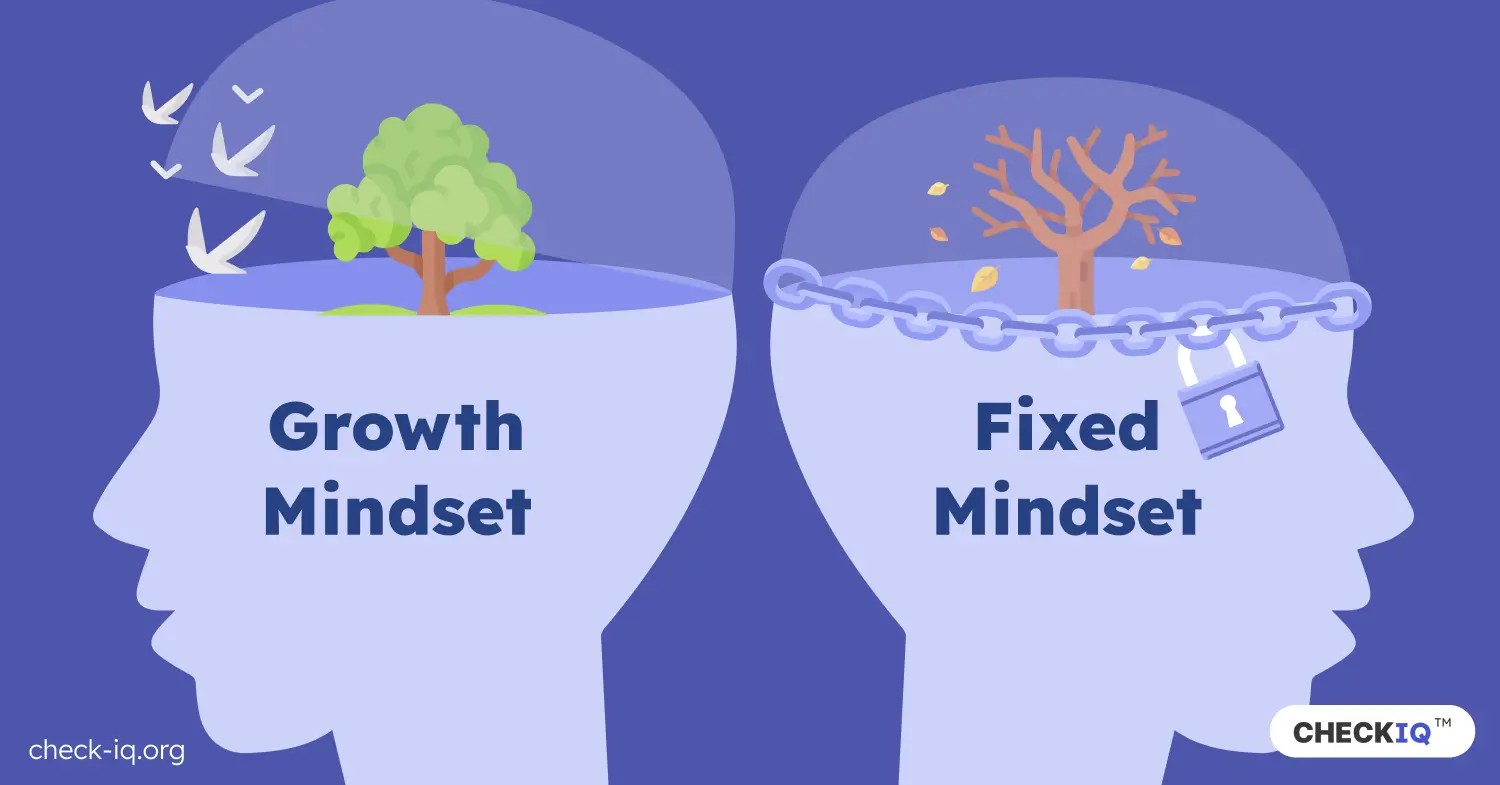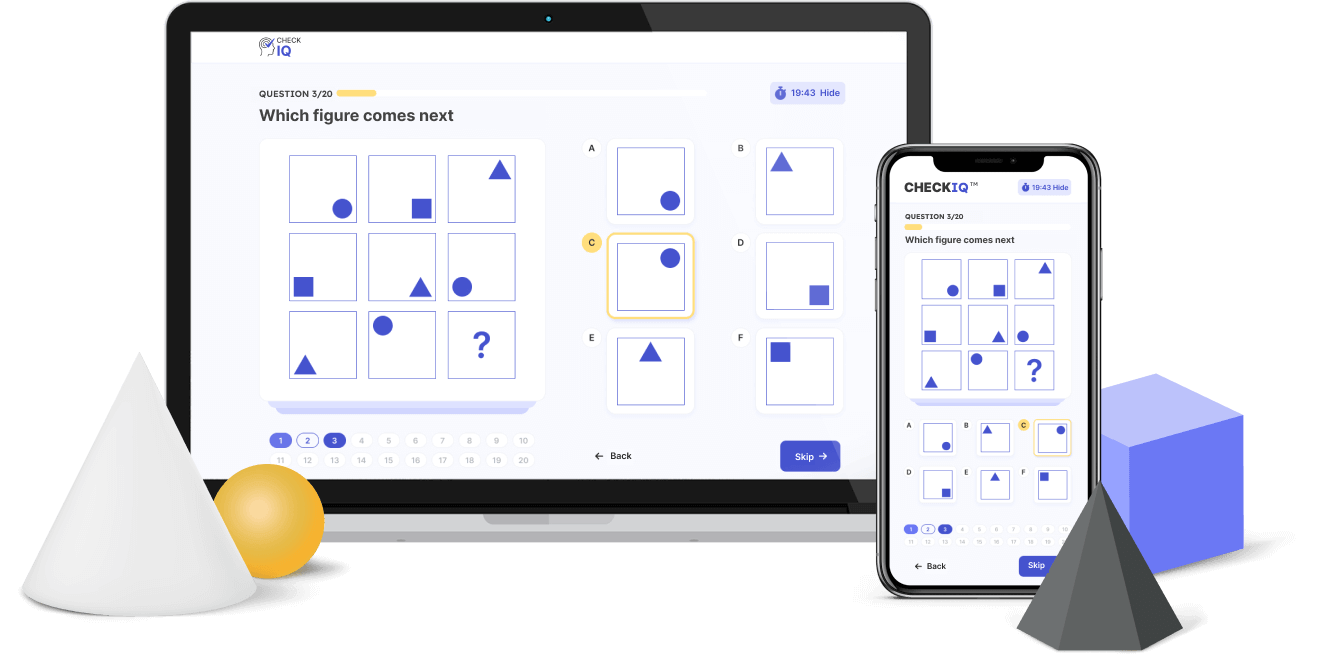IQ tests are often associated with measuring the intelligence of children, they are equally significant for adults. While their origins lie in identifying students needing educational support, modern IQ assessments have matured to encompass a wider range of purposes, including evaluating cognitive abilities in adults.
Today, we’ll go through the IQ test options available for adults.
1. The Evolution of IQ Tests
IQ tests have evolved significantly since their inception. It all began in the early 20th century with a French psychologist named Alfred Binet. Binet, alongside his colleague Théodore Simon, developed the first practical intelligence test in response to the need for identifying students who required additional educational support in schools.
Unlike the more abstract concept of general intelligence, Binet's test focused on specific tasks that were believed to indicate a person's mental agility. These tasks included memory recall, attention to detail, and problem-solving ability. Over time, these early forms of intelligence testing would grow more sophisticated, branching off into various types that catered to different aspects of cognitive function.
As the testing methods branched out, one particular version made its way from France to the United States, where it was revised by Lewis Terman, a psychologist at Stanford University, and became known as the Stanford-Binet Intelligence Scales.
This test emphasized fluid intelligence – the ability to think and reason abstractly, which was considered a core component of general intelligence. The development of the Stanford-Binet test marked an important milestone in cognitive function testing, thus leading to the modern IQ tests in use today.
A reliable 100% adaptive online IQ Test. Get your IQ score immediately.
Start My IQ Test
2. Why Are There Different IQ Test Types?
There are many types of IQ tests simply because intelligence is also multi-dimensional. Different tests measure distinct cognitive abilities, such as verbal reasoning, memory processing, spatial awareness, and mathematical aptitude.
IQ tests cannot be one-size-fits-all. For example, someone may excel at linguistic challenges but struggle with numerical puzzles and vice versa. Varied tests help educators, psychologists, and employers better assess and support individuals.
Additionally, different tests allow for fairer assessments across various cultural backgrounds and languages. This ensures a more nuanced understanding of an individual's intelligence and prevents overlooking unique cognitive talents.
3. Types of IQ Tests for Adults
Here are the major types of IQ tests suitable and highly recommended for adults.
Stanford-Binet Intelligence Scales
The Stanford-Binet Intelligence Scale is one of the most respected IQ tests ever created. Originating from Alfred Binet's work and suitable for all ages, this test looks at five key areas: fluid reasoning, knowledge, quantitative reasoning, visual-spatial processing, and working memory. Each area helps us understand different parts of a person's intelligence.
Over the years, Stanford researchers have updated the test to keep it accurate and relevant for everyone.
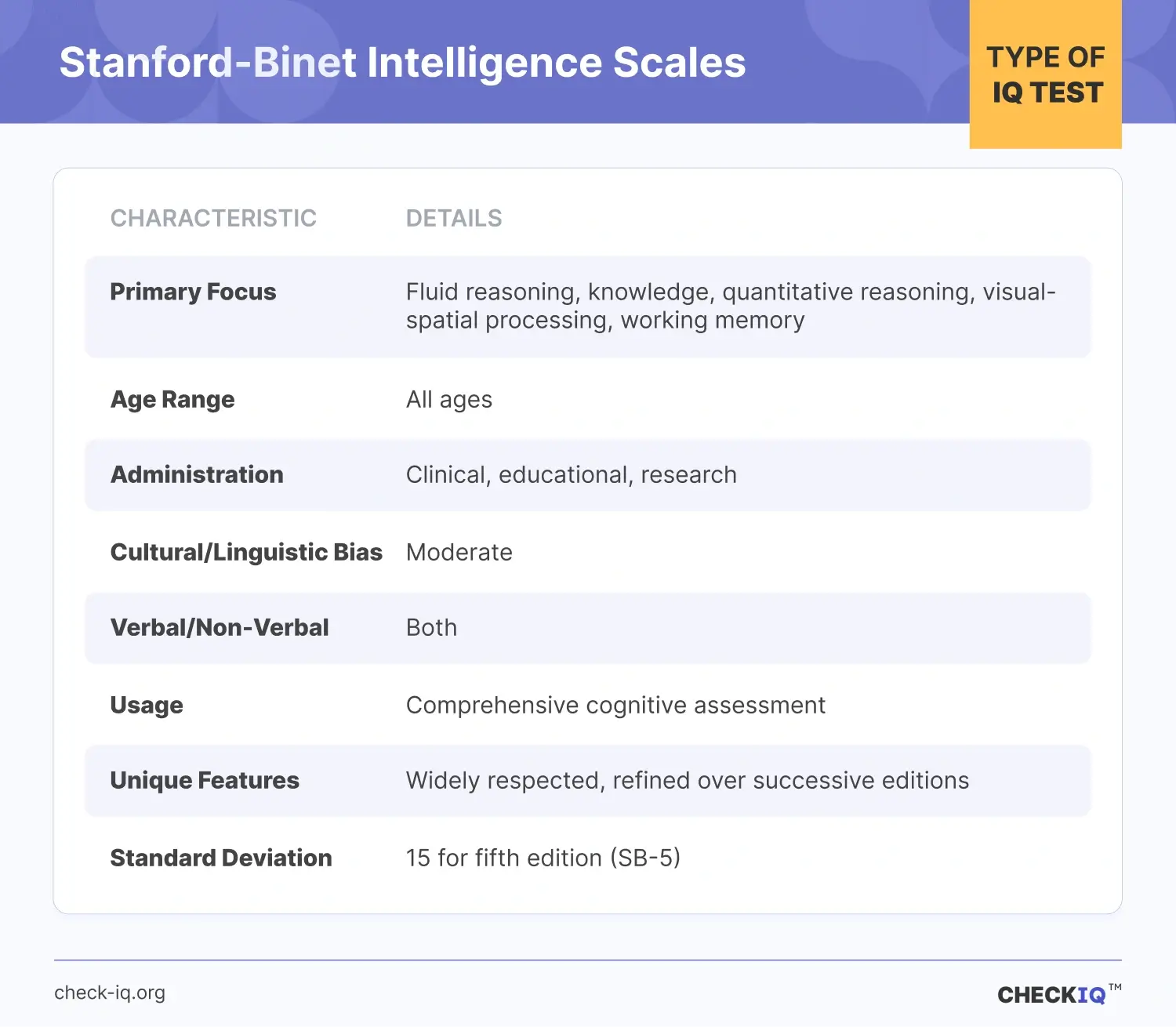
Older versions of the Stanford-Binet Intelligence Scales were using a standard deviation of 16. The shift from a standard deviation of 16 to 15 for the Stanford-Binet Intelligence Scales occurred with the release of the Stanford-Binet Intelligence Scales, Fifth Edition (SB5) in 2003.
Raven’s Progressive Matrices
Often simply called 'Raven,' the Raven's Progressive Matrices is renowned for its non-verbal nature, making it suitable across cultures and languages. It assesses abstract reasoning and is particularly good at measuring what's known as 'g' or general intelligence.
Raven’s Progressive Matrices present a series of patterns with a missing piece that the test-taker must identify from multiple options. This test sidesteps the cultural and educational biases that can affect the results of more language-dependent IQ tests, offering a different perspective on intelligence.
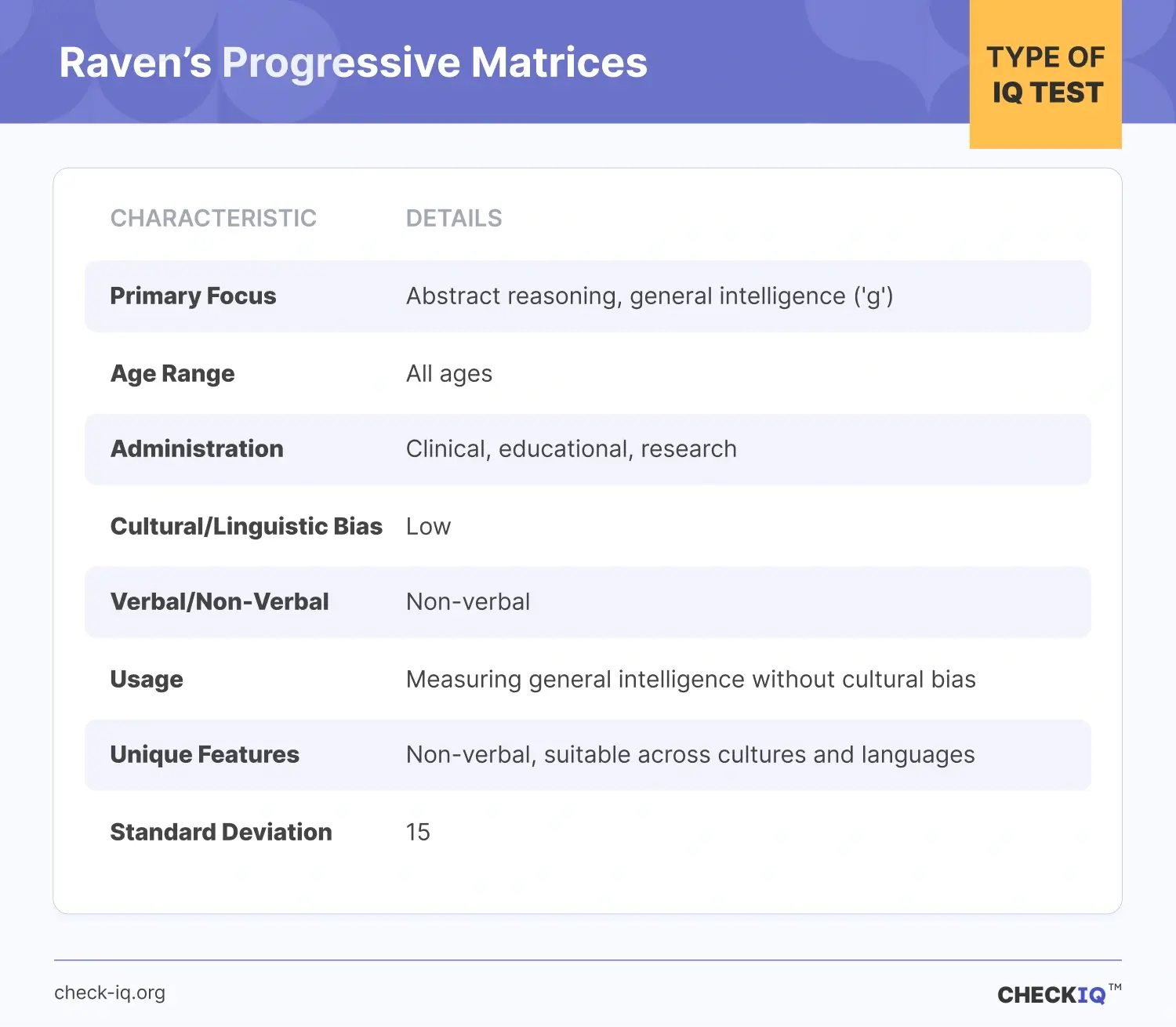
Woodcock-Johnson Tests of Cognitive Abilities
Next on the list, the Woodcock-Johnson Tests offer a broad lens on human cognition. So, where do these tests fit in the grand panorama of IQ assessments? The Woodcock-Johnson batteries focus on cognitive strengths and weaknesses across various areas. Administered to individuals from age two to adulthood, it's composed of tests that span oral language, mathematics, reading, and writing skills.
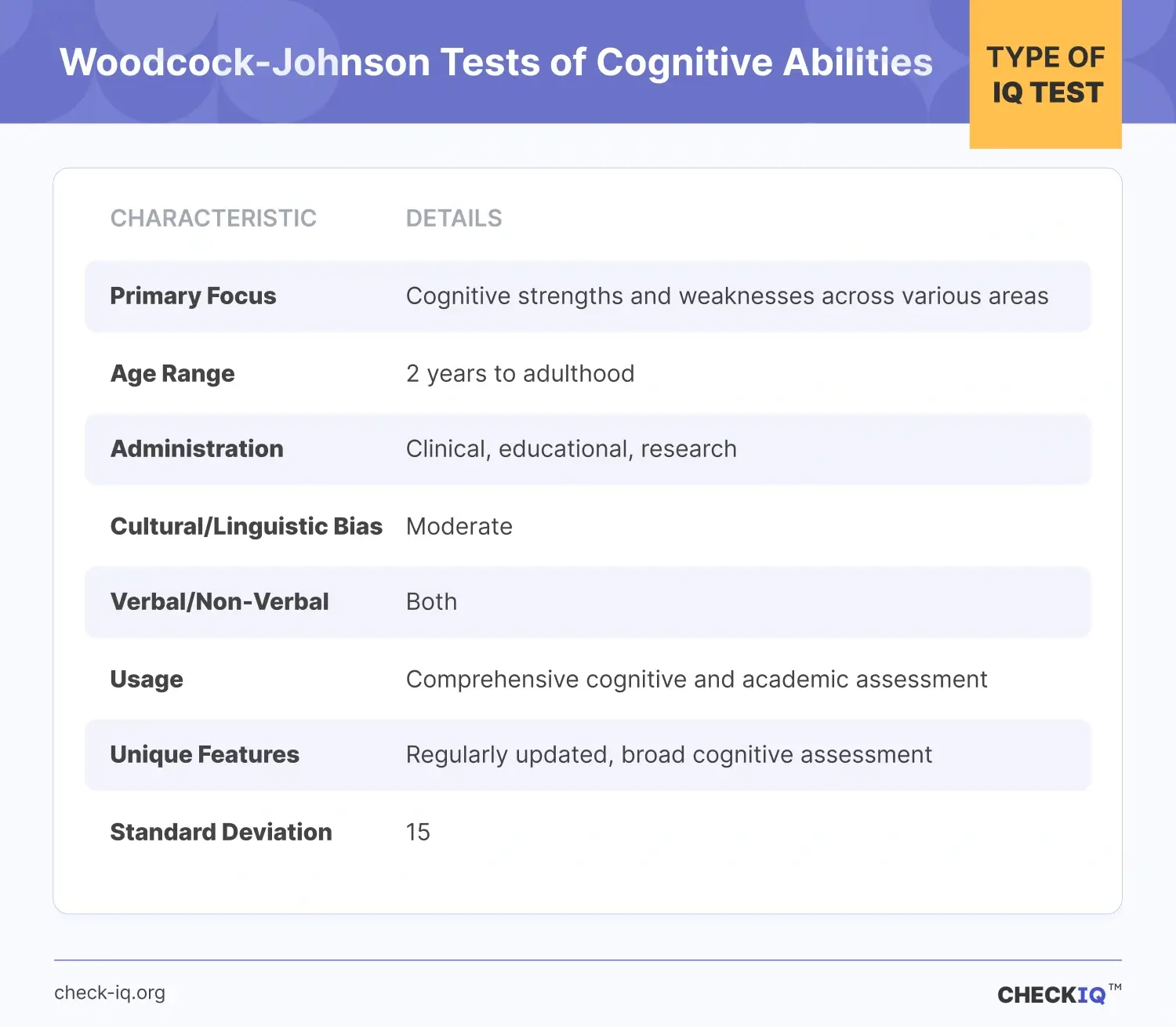
Wechsler Adult Intelligence Scale (WAIS)
The Wechsler Adult Intelligence Scale (WAIS) is designed for testing the intelligence of adults and older adolescents, aged 16 and over. It provides a comprehensive measure of cognitive ability, including verbal comprehension, perceptual reasoning, working memory, and processing speed. The WAIS is widely used in clinical, educational, and research settings to assess cognitive strengths and weaknesses, diagnose learning disabilities, and evaluate neurological and psychiatric disorders.
The Wechsler suite, including the WAIS for adults and older adolescents (aged 16+), extends to younger demographics with the WISC for children (6-16 years) and the WPPSI for early childhood (2.5-7.5 years).
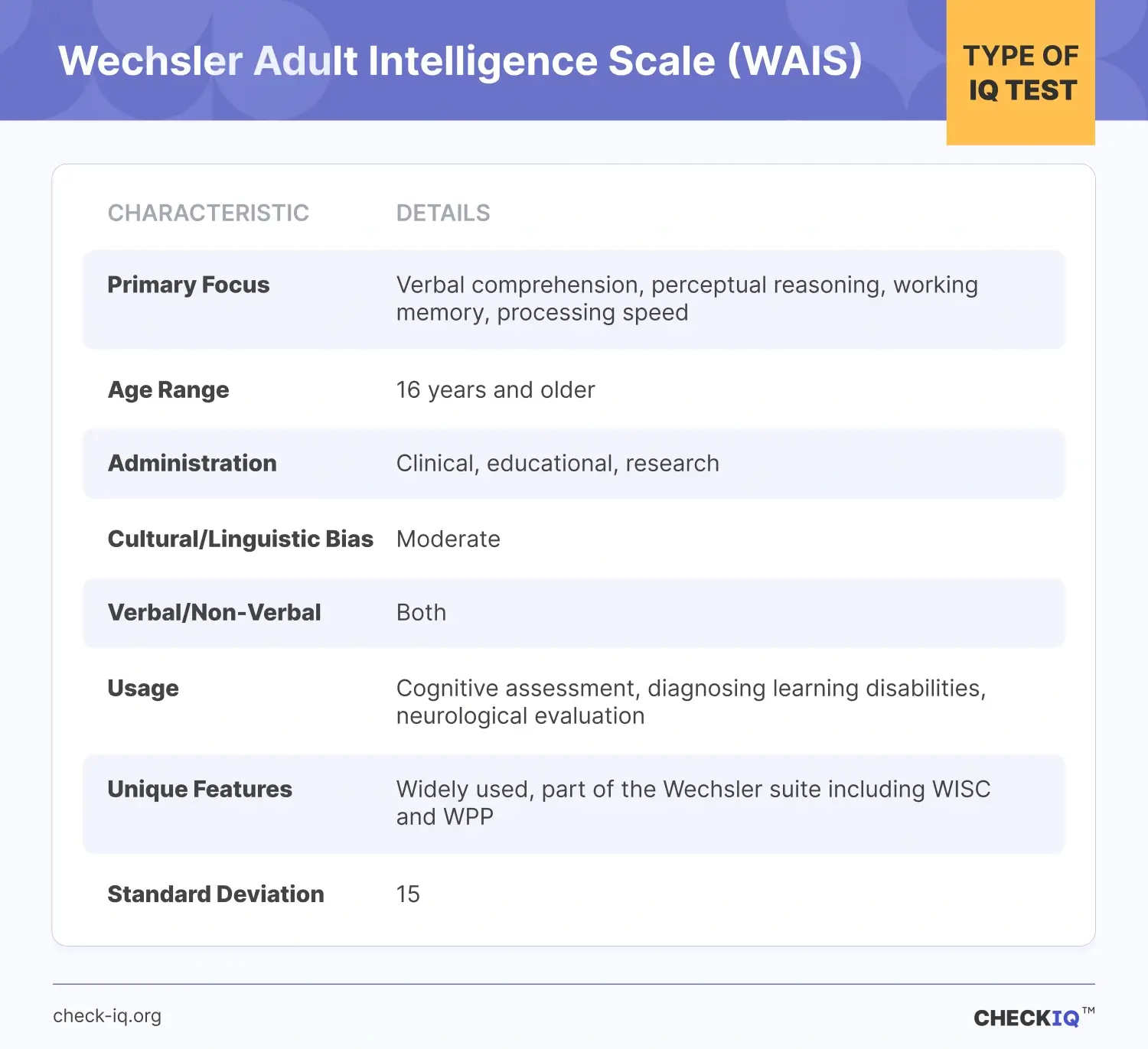
Cattell’s Culture Fair Intelligence Test (CFIT)
A standout for its effort to minimize cultural and language bias, the Cattell’s Culture Fair Intelligence Fair test aims to provide an equitable measure of intelligence across diverse populations. It focuses on nonverbal abilities and assesses fluid intelligence through abstract and spatial reasoning tasks. The test is particularly favored in situations where testers come from varied cultural backgrounds or where English is not the first language, offering a more level playing field in measuring intellectual potential.

Contrary to most contemporary intelligence tests which use a standard deviation of 15, the Cattell Culture Fair Intelligence Test (CFIT) uses a standard deviation of 16 for its standard scores.
Universal Nonverbal Intelligence Test - Second Edition (UNIT-2)
The Universal Nonverbal Intelligence Test - Second Edition (UNIT-2) is designed to provide a comprehensive assessment of intelligence without relying on language. This makes it particularly suitable for people who are non-English speakers, deaf, or have other communication disorders. By focusing on nonverbal measures of intelligence, including symbolic memory, spatial processing, and problem-solving, the UNIT-2 offers an equitable testing option that reduces cultural and linguistic bias.
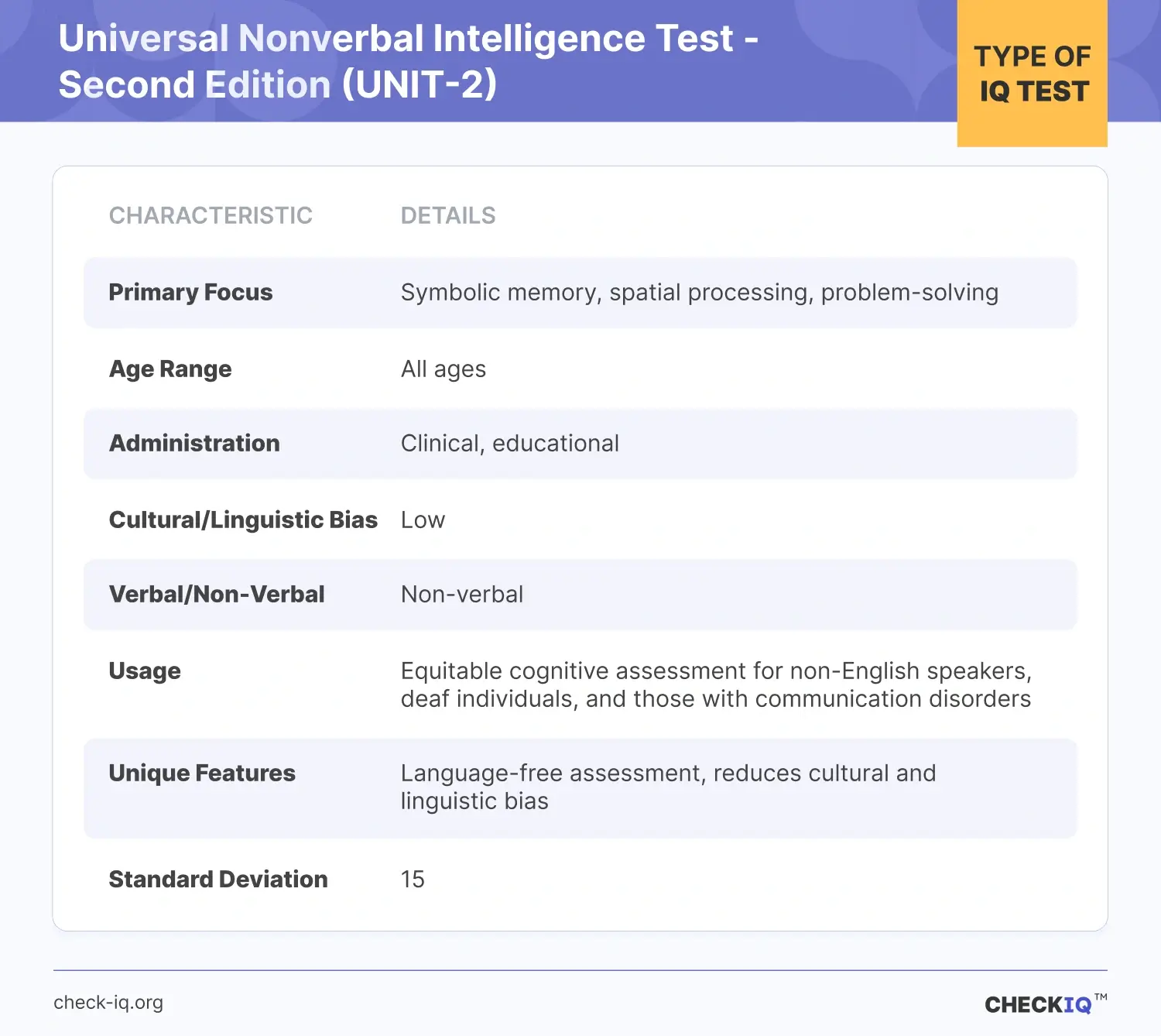
The Multidimensional Aptitude Battery II (MAB-II) Test
The Multidimensional Aptitude Battery II (MAB-II) looks at both verbal and performance skills, covering areas like how you process information, understand words, organize things you see, and work with numbers and spaces. The MAB-II is used in many places, such as clinics, schools, and research labs
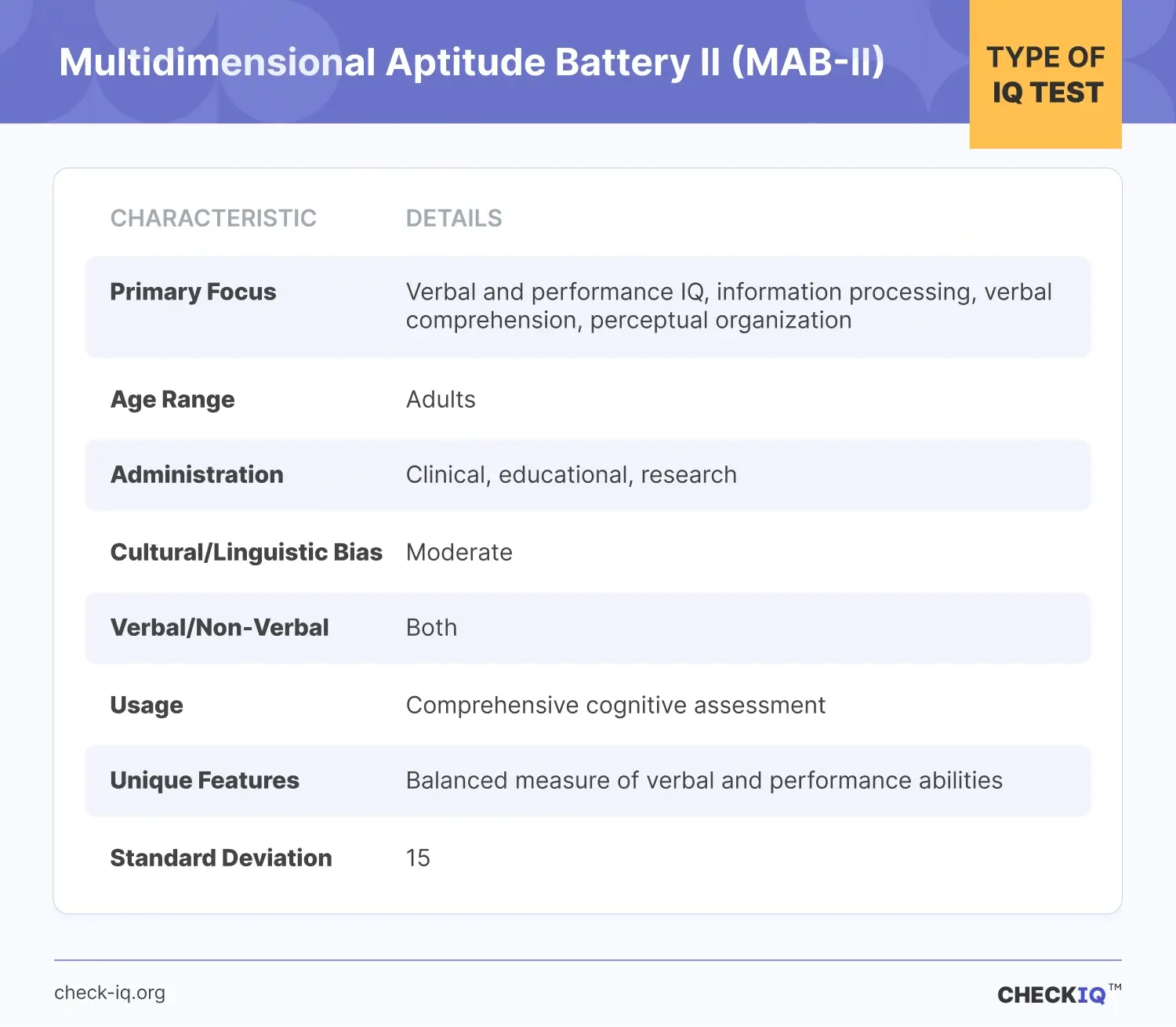
Mensa Admission Test
The Mensa Admission Test is unique as it's specifically designed for one purpose: to qualify individuals for membership into Mensa, one of the most renowned high-IQ societies. Unlike traditional IQ tests that cover a broad spectrum of cognitive abilities, the Mensa test focuses on logical and verbal reasoning. The test comprises two separate assessments, and applicants must score at the 98th percentile or higher (so must be in the top 2%) on at least one of these tests to be eligible for Mensa membership.
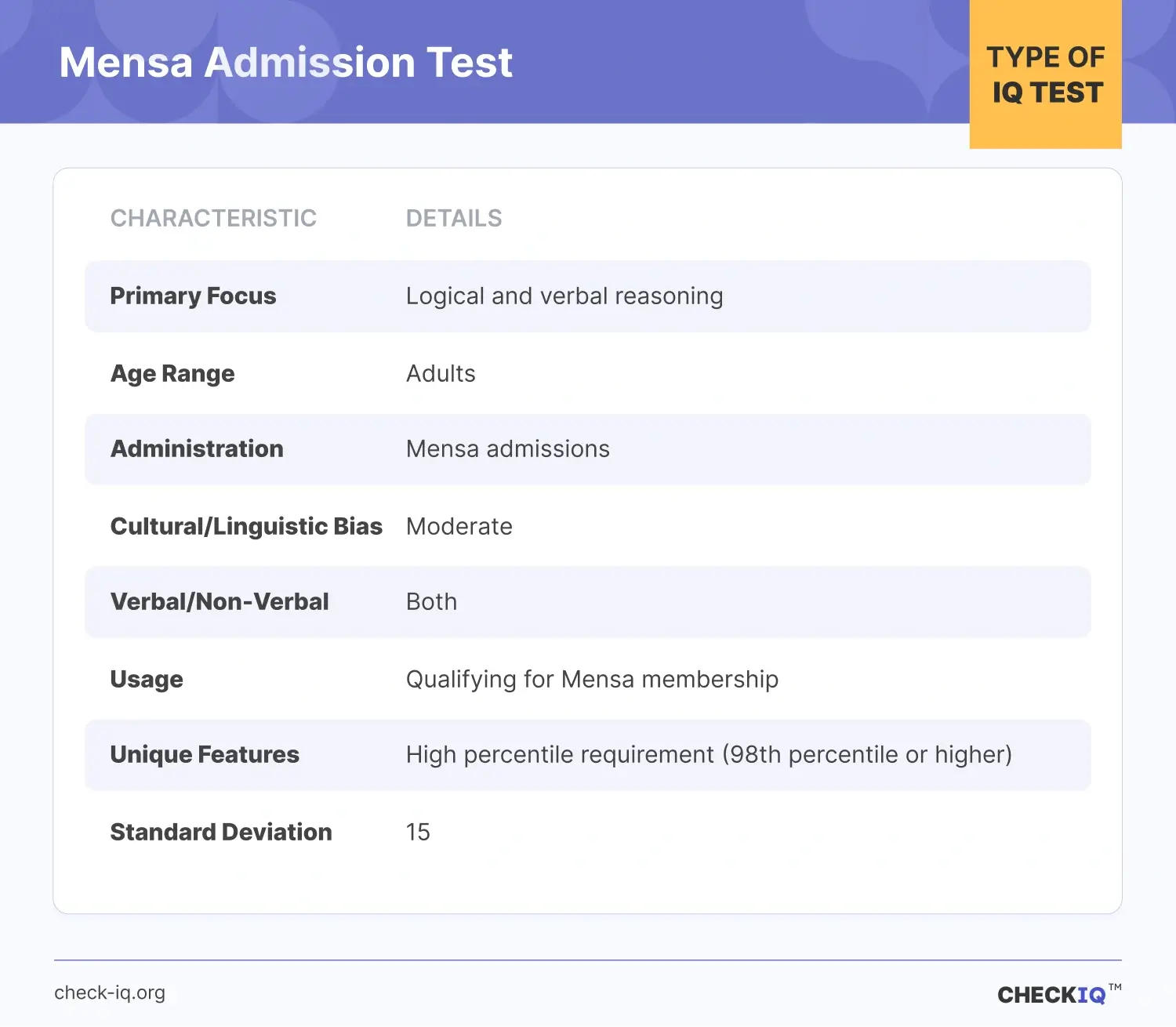
4. How do IQ Tests Work
IQ tests present a series of questions that assess a variety of mental abilities to create a comprehensive profile of your cognitive strengths. They often evaluate skills such as:
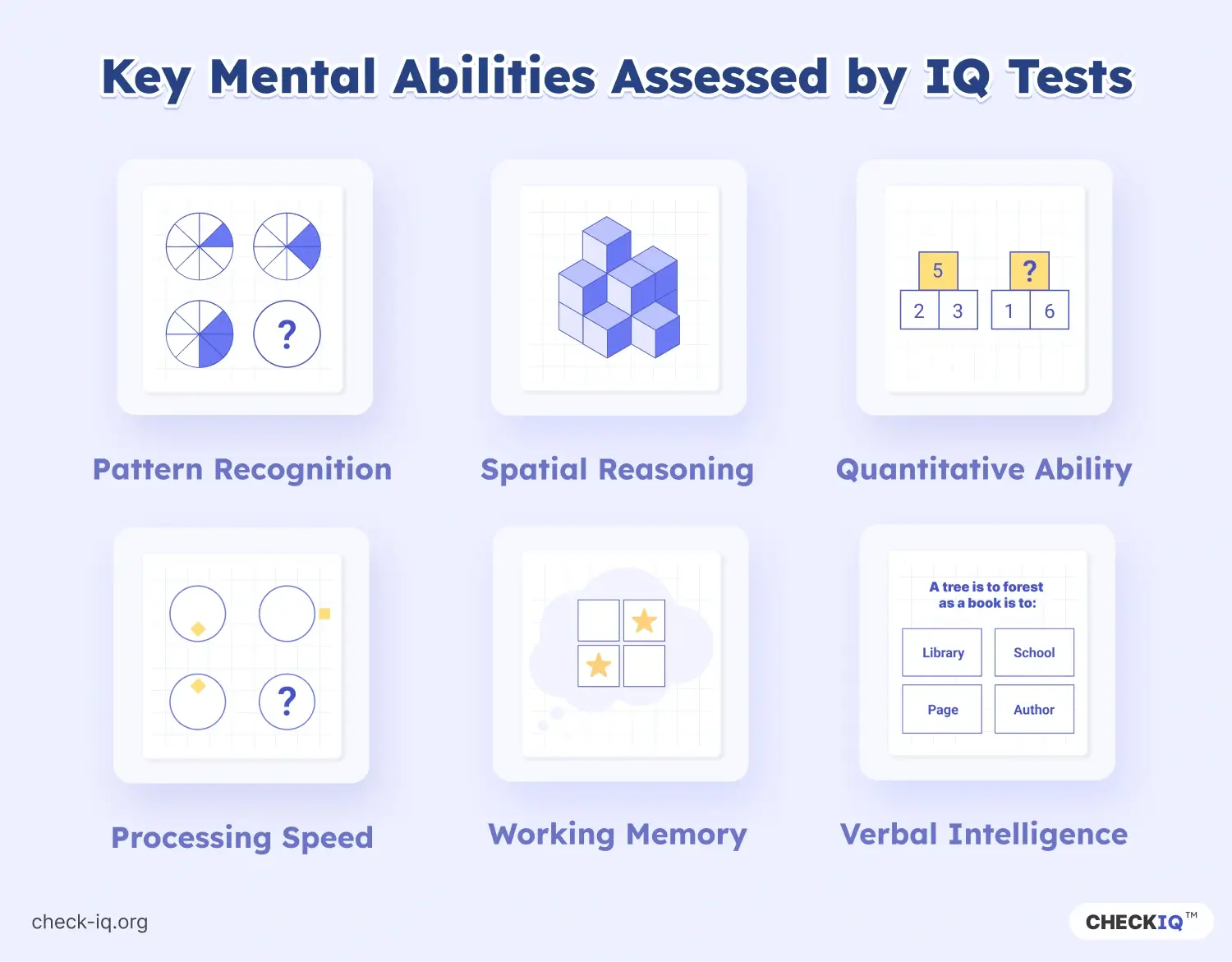
- Pattern recognition: Identifying and solving abstract problems, which are vital for logical thinking and problem-solving.
- Spatial reasoning: Visualizing objects and spatial dimensions in your mind, crucial for fields like engineering or architecture.
- Quantitative ability: Understanding and working with numbers.
- Processing speed: Quickly looking at and processing visual information, such as symbols or numbers, which is advantageous for making quick decisions or analyzing data swiftly.
- Working memory: Retaining and manipulating information over short periods, essential for problem-solving and following multi-step directions. A good working memory is linked to intelligence, but it’s not necessarily a sign of a higher IQ.
- Verbal intelligence: Understanding and using language effectively, though this can be biased against non-native speakers.
After you answer the questions, your responses are scored and compared to a normative sample, typically resulting in a standard score with an average value of 100. By systematically evaluating these diverse skills, IQ tests aim to create a detailed profile of your mental abilities.This helps identify particular talents or areas where you might benefit from additional challenges or support.
5. How to interpret the results
IQ test scores can seem a bit mysterious at first. What exactly do these numbers mean? Essentially, an IQ score is derived from a set of standardized tests that assess human cognitive abilities in relation to the general population.
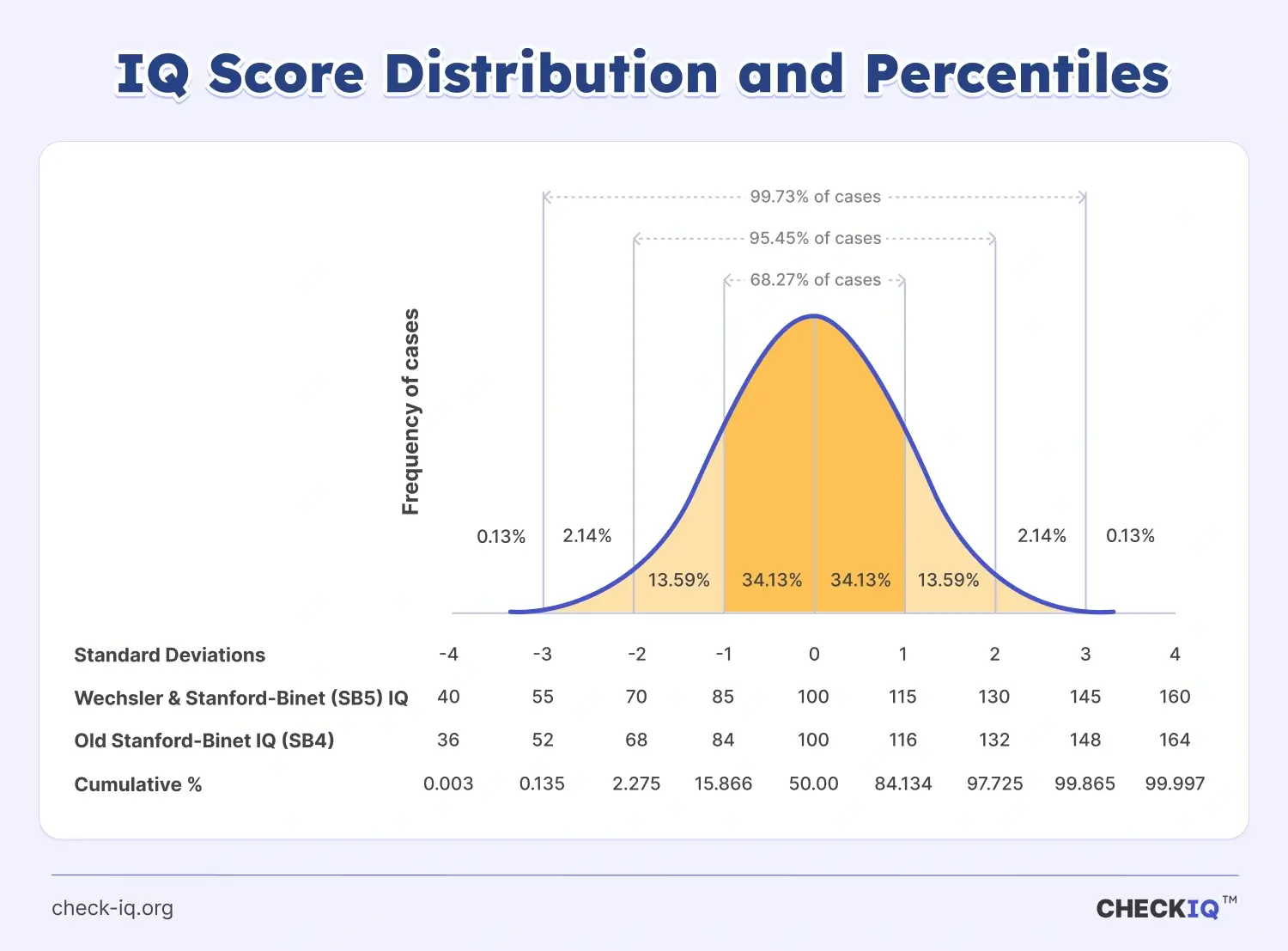
Here's how it works: After taking the test, your raw score (the number of questions you answered correctly) is converted into a standard score. This standard score is then placed on a bell curve, or normal distribution, where the average score is set at 100. Most people score within the middle range of this curve, between 85 and 115. A smaller percentage of people score either significantly below or above this average, with each standard deviation typically being 15 points. This placement helps psychologists determine how your cognitive abilities compare to the general population, identifying your strengths and areas for improvement.
How to read the IQ bell curve
Understanding your IQ score is easier when you know how to read the IQ bell curve. Here is what you need to know:
- Average IQ score
The benchmark in IQ testing is the average score, which is set at 100. On either side of this average, there is a spread of scores that encompass the majority of the population, typically ranging from 85 to 115. 68% of the population falls within that range, according to the properties of a normal distribution in statistics. In other words, the majority of people have an IQ between 85 and 115.
- Above and below average IQ scores
As we look at the curve, scores above 115 indicate stronger than average cognitive abilities. These higher IQ scores suggest an individual has certain cognitive skills – like problem-solving agility, logical reasoning, and conceptual understanding – at a level that is above the norm for their age group. To be more specific, if your IQ is above 115, you are in the top 16% of all test takers.
Conversely, scores below 85 suggest there may be areas where an individual could benefit from additional support or intervention. 16% of people have an IQ at or below 85.
- Understanding standard deviation
The curve is marked by standard deviations, each representing a 15-point interval on the IQ scale. These standard deviations help in comparing scores between different types of IQ tests, like the Wechsler and Stanford-Binet scales.
A standard deviation is a measure of the amount of variation or dispersion in a set of values. In the context of IQ scores, one standard deviation from the average (100) is 15 points. This means that if you move 15 points above or below the average IQ score, you are one standard deviation away from the mean.
- Understanding percentiles
Percentiles indicate the relative standing of a score within a larger distribution of scores. For instance, a score that is two standard deviations above the mean, which would be 130 on the Wechsler or on the Stanford-Binet, places an individual in approximately the 98th percentile. A 98th percentile implies that you’ve scored higher than 98% of your peers.
- 15 vs 16 standard deviation
Most IQ tests use a 15-point standard deviation. But Cattell’s Culture Fair Intelligence Test and older versions of Stanford-Binet test, use a 16-point standard deviation. With a 16-point standard deviation, a 130 IQ corresponds to the top 3% of all test takers, but with a 15-point standard deviation, it corresponds to the top 2%.
4. Are IQ Tests Useful?
IQ tests are definitely useful. They play a significant role in various fields, contributing to our understanding and application of human intelligence.
In educational systems, these standardized tests are used to identify students who may need additional support or those who might benefit from gifted education programs. The results help create tailored learning strategies that accommodate a range of learning abilities, including those with learning disabilities. Signs of lower IQ, such as difficulties in problem-solving, slower learning pace, or challenges in understanding complex concepts, can be identified early, allowing for interventions that can provide the necessary support and resources to help these students succeed.
In the professional world, some companies use IQ tests as a gauge of a candidate's problem-solving ability and adaptability. Although the practice is controversial, scores are sometimes considered during the hiring process, especially for jobs that require a high degree of critical thinking or complex skill sets.
On a broader scale, IQ tests provide valuable data for psychologists and researchers studying how intelligence develops and changes across the lifespan. For individuals, these tests offer a snapshot of cognitive strengths and weaknesses, which can be informative when considering career paths or academic endeavors. For example, if your score suggests strong analytical skills, careers or hobbies involving meticulous investigation or strategic planning could be particularly rewarding. Alternatively, if the test indicates formidable creative thinking, pursuits in the arts or innovation may be a good fit.
Finally, IQ test results can be a tool for personal development. The key lies in understanding your cognitive profile and using that knowledge to direct your learning or career path. It's essential to approach IQ tests and their results not as verdicts of your worth or ability but as starting points for growth. They are tools that can help you ask the right questions about how you learn, think, and approach problems.
5. The Limitations of IQ Tests in Measuring Complete Intelligence
IQ tests are renowned for quantifying cognitive abilities, yet they do not capture the entirety of an individual's intelligence.
For example, the popular IQ test types we’ve covered don’t evaluate emotional intelligence (EQ), which corresponds to recognizing, comprehending, and managing our own emotions as well as the emotions of others. Emotional intelligence is pivotal in both personal growth and professional success. In the context of the workplace, EQ is often linked to enhanced leadership, better teamwork, and improved client relations. Arguably, EQ is often more important than IQ in that context.
Remarkably, a reported 75% of Fortune 500 companies have implemented emotional intelligence training tools, signaling a corporate shift towards recognizing the value of these competencies alongside traditional cognitive skills.
Similarly, interpersonal intelligence, which involves the ability to understand and interact effectively with others, is often underrepresented in traditional IQ assessments. This includes sensitivity to the moods, feelings, temperaments, and motivations of people, and the capacity to cooperate in order to work as part of a group. Individuals with high interpersonal intelligence are often successful in teaching, counseling, politics, and sales roles where understanding and interacting with others is a key component of the job.
As a last example, let’s talk about musical intelligence – the capacity to discern pitch, rhythm, timbre, and tone, which can influence a person's ability to create, perform, and appreciate music. This form of intelligence is important for composers, musicians, and music enthusiasts who can understand and express themselves through musical forms.
6. Frequently Asked Questions on IQ Tests
Is it possible to improve your IQ test score?
The short answer is yes, to some extent. While inherent ability plays a significant role in determining scores, there are strategies that can help you prepare for and perform your best on an IQ test.
Practice tests, for instance, familiarize you with the format of IQ questions and can reduce test anxiety – helping you to work more efficiently under timed conditions.
Engaging in various cognitive exercises – such as puzzles, reading, and learning new skills – may also positively influence your test performance. These activities keep your brain active and can improve aspects of cognitive function, such as memory and processing speed. It's important to note, however, that while you can improve how you perform on an IQ test, these changes may not necessarily reflect a change in your underlying cognitive ability.
Scientific evidence shows that physical activity, particularly aerobic fitness, improves cognitive health and function. Active individuals process information more quickly and allocate greater attentional resources. Exercise affects cognition by influencing energy metabolism and synaptic plasticity, often complemented by healthy dietary choices.
Additionally, the Flynn effect shows that average IQ scores have increased over generations due to factors such as improved education, nutrition, and overall living conditions. This indicates that environmental factors can significantly impact cognitive performance.
It's important to note that while genetics play a role in intelligence, IQ test scores can also be influenced by factors such as age, educational opportunities, and access to resources. Approach IQ tests as tools for growth, helping you understand and enhance your learning and problem-solving skills.
Are there any IQ tests for kids?
Absolutely, children can be assessed for their cognitive abilities through various specialized IQ tests. These tests are tailored to match the developmental stages of children, ensuring that the results are age-appropriate and relevant. Some of the widely recognized IQ tests for children include:
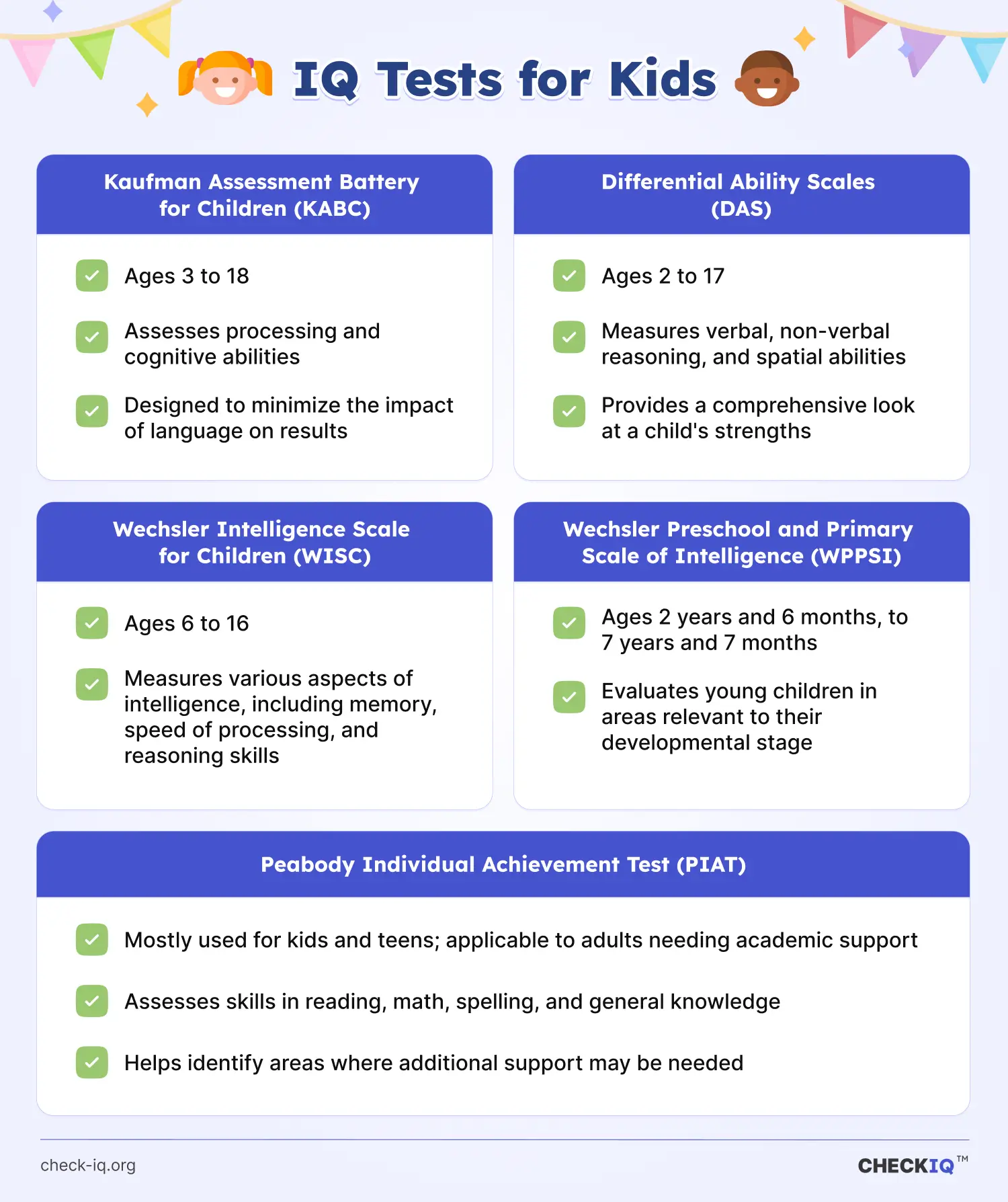
- Kaufman Assessment Battery for Children (KABC): Designed for ages 3 to 18, this test assesses processing and cognitive abilities in a way that minimizes the impact of language.
- Differential Ability Scales (DAS): Suited for ages 2 through 17, the DAS measures verbal, non-verbal reasoning, and spatial abilities, providing a comprehensive look at a child's strengths.
- Wechsler Intelligence Scale for Children (WISC): The WISC is targeted at children between 6 and 16 years old and measures different aspects of intelligence, including memory, speed of processing, and reasoning skills.
- Wechsler Preschool and Primary Scale of Intelligence (WPPSI): Specifically designed for younger children, ages 2 years and 6 months to 7 years and 7 months, the WPPSI evaluates little ones in areas relevant to their developmental stage.
- Peabody Individual Achievement Test (PIAT): The PIAT is mostly used for kids and teens to check their skills in reading, math, spelling, and general knowledge. It can also help adults going back to school or needing extra help by showing areas where they need support.





